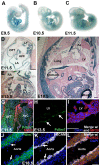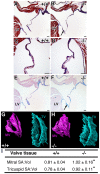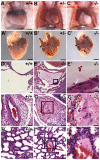Loss of the cytoskeletal protein Pdlim7 predisposes mice to heart defects and hemostatic dysfunction
- PMID: 24278323
- PMCID: PMC3835322
- DOI: 10.1371/journal.pone.0080809
Loss of the cytoskeletal protein Pdlim7 predisposes mice to heart defects and hemostatic dysfunction
Abstract
The actin-associated protein Pdlim7 is essential for heart and fin development in zebrafish; however, the expression and function of this PDZ-LIM family member in the mammal has remained unclear. Here, we show that Pdlim7 predominantly localizes to actin-rich structures in mice including the heart, vascular smooth muscle, and platelets. To test the requirement for Pdlim7 in mammalian development and function, we analyzed a mouse strain with global genetic inactivation of Pdlim7. We demonstrate that Pdlim7 loss-of-function leads to significant postnatal mortality. Inactivation of Pdlim7 does not disrupt cardiac development, but causes mild cardiac dysfunction in adult mice. Adult Pdlim7(-/-) mice displayed increased mitral and tricuspid valve annulus to body weight ratios. These structural aberrations in Pdlim7(-/-) mice were supported by three-dimensional reconstructions of adult cardiac valves, which revealed increased surface area to volume ratios for the mitral and tricuspid valve leaflets. Unexpectedly, we found that loss of Pdlim7 triggers systemic venous and arterial thrombosis, leading to significant mortality shortly after birth in Pdlim7(+/-) (11/60) and Pdlim7(-/-) (19/35) mice. In line with a prothrombotic phenotype, adult Pdlim7(-/-) mice exhibit dramatically decreased tail bleed times compared to controls. These findings reveal a novel and unexpected function for Pdlim7 in maintaining proper hemostasis in neonatal and adult mice.
Conflict of interest statement
Figures






Similar articles
-
PDLIM7 Synergizes With PDLIM2 and p62/Sqstm1 to Inhibit Inflammatory Signaling by Promoting Degradation of the p65 Subunit of NF-κB.Front Immunol. 2020 Aug 4;11:1559. doi: 10.3389/fimmu.2020.01559. eCollection 2020. Front Immunol. 2020. PMID: 32849529 Free PMC article.
-
Pdlim7 Regulates Arf6-Dependent Actin Dynamics and Is Required for Platelet-Mediated Thrombosis in Mice.PLoS One. 2016 Oct 28;11(10):e0164042. doi: 10.1371/journal.pone.0164042. eCollection 2016. PLoS One. 2016. PMID: 27792740 Free PMC article.
-
PDLIM7 is a novel target of the ubiquitin ligase Nedd4-1 in skeletal muscle.Biochem J. 2016 Feb 1;473(3):267-76. doi: 10.1042/BJ20150222. Epub 2015 Nov 10. Biochem J. 2016. PMID: 26556890
-
Lymphovenous hemostasis and the role of platelets in regulating lymphatic flow and lymphatic vessel maturation.Blood. 2016 Sep 1;128(9):1169-73. doi: 10.1182/blood-2016-04-636415. Epub 2016 Jul 6. Blood. 2016. PMID: 27385789 Review.
-
New insights into the roles of Xin repeat-containing proteins in cardiac development, function, and disease.Int Rev Cell Mol Biol. 2014;310:89-128. doi: 10.1016/B978-0-12-800180-6.00003-7. Int Rev Cell Mol Biol. 2014. PMID: 24725425 Free PMC article. Review.
Cited by
-
Proximity proteomics of synaptopodin provides insight into the molecular composition of the spine apparatus of dendritic spines.Proc Natl Acad Sci U S A. 2022 Oct 18;119(42):e2203750119. doi: 10.1073/pnas.2203750119. Epub 2022 Oct 10. Proc Natl Acad Sci U S A. 2022. PMID: 36215465 Free PMC article.
-
Mutations in PDLIM5 are rare in dilated cardiomyopathy but are emerging as potential disease modifiers.Mol Genet Genomic Med. 2020 Feb;8(2):e1049. doi: 10.1002/mgg3.1049. Epub 2019 Dec 27. Mol Genet Genomic Med. 2020. PMID: 31880413 Free PMC article.
-
SRSF3 maintains transcriptome integrity in oocytes by regulation of alternative splicing and transposable elements.Cell Discov. 2018 Jun 19;4:33. doi: 10.1038/s41421-018-0032-3. eCollection 2018. Cell Discov. 2018. PMID: 29928511 Free PMC article.
-
PDLIM7 Synergizes With PDLIM2 and p62/Sqstm1 to Inhibit Inflammatory Signaling by Promoting Degradation of the p65 Subunit of NF-κB.Front Immunol. 2020 Aug 4;11:1559. doi: 10.3389/fimmu.2020.01559. eCollection 2020. Front Immunol. 2020. PMID: 32849529 Free PMC article.
-
Pdlim7 Regulates Arf6-Dependent Actin Dynamics and Is Required for Platelet-Mediated Thrombosis in Mice.PLoS One. 2016 Oct 28;11(10):e0164042. doi: 10.1371/journal.pone.0164042. eCollection 2016. PLoS One. 2016. PMID: 27792740 Free PMC article.
References
Publication types
MeSH terms
Substances
Grants and funding
LinkOut - more resources
Full Text Sources
Other Literature Sources
Medical
Molecular Biology Databases
Miscellaneous

